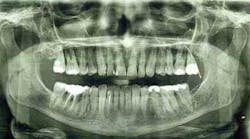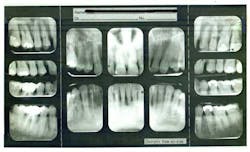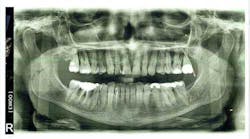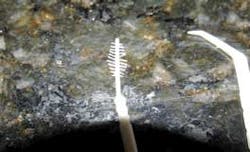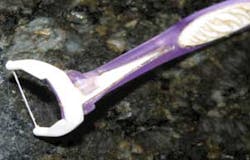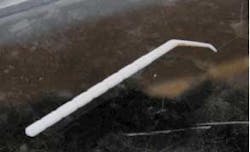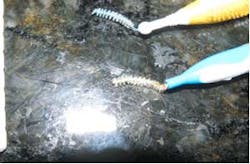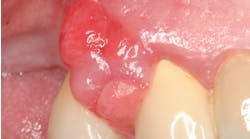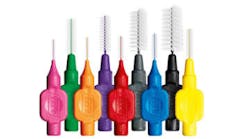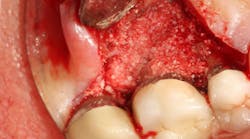A patient's perspective on the importance of tooth-sparing periodontal treatment
Background
In mid-2010 or so, after a long period of dental neglect, I started to have vague and general pains mouth-wide at the gumline. My dental hygiene up to that time had been for a long time a ritualized form of electric toothbrushing without toothpaste. I had read once that toothpaste was not very relevant to dental hygiene; rather, the brushing action was the decay-prevention mechanism.
ADDITIONAL READING |Localized aggressive periodontitis: All-On-4 oral rehabilitation case report
Because I had a regular dentist whom I did not like, I went shopping for a dentist. I selected an approved dentist on my health plan and ended up at a lower-priced and higher-volume clinic type of office. I was diagnosed as needing “deep cleaning,” a new term to me (done under local anesthesia, all four quadrants), and I heard for the first time that I had extensive periodontal bone loss as shown by the periodontal chart (figure 1). I had one quadrant done, felt the service there was not sufficient, and decided to go to another office.
Figure 1: Periodontal charting
Figure 2: Full-mouth series
Figure 2a: Panoramic x-ray
Because of my severe bone-loss condition (figures 2 and 2a), I was advised by many offices that my treatment should consist of: extraction, bone grafts, sinus lifts, implants, and crowns. This was very expensive and, I felt, very invasive. I was reluctant, preferring to try to keep my teeth.
Thus, I set myself to learn about periodontics; and began to search terms such as “NYC periodontists.” I had worked in medicine and knew some buzzwords. I decided that bone grafting should be able to save my teeth. I was willing to give the “saving the teeth” option a try, and if all else failed, I could go with dental implants down the road.
I learned about osteogenesis, osteoinduction, scaffolding, osteoblasts, and the several types of growth factors, and so I went dentist shopping being a somewhat informed layperson.
ADDITIONAL READING | Understanding and managing peri-implant bone loss
I e-mailed several dentists and discovered each had an individual and differing approach as to what was needed, but all offered extraction, implants, and crowns. I rejected all. I ended up choosing Dr. Scott Froum, a periodontist, because he gave me an option to save my teeth. He did point out that extensive grafting and implants were an option, but trying to do periodontal treatment to save my teeth was also a possibility. I gather that this sort of “saving the teeth” approach is not taught in dental schools as the primary response?
Periodontal treatment
The first part of the treatment consisted of the deep cleanings that got me ready for the surgical part. I began to take a real interest in my hygiene (as I will explain later), as I understood this to be important to maintain the end result. The second part of my treatment consisted of putting a strap around my teeth and bonding them together. I later found out that this was a “splint” and would brace my looser teeth to those that were stronger. The third part of my treatment is better explained by Dr. Froum, but as I understand it, consisted of doing quadrants of surgery using bone grafts, growth factors, and membranes in order to “rebuild” the lost bone around my teeth. I ended up spending low-five-figure amounts, and figured I got off light since the extraction/implant plan was close to six figures.
It has been five years now, and after being initially told that most of my teeth needed to be replaced by dental implants, I have only had one extracted. Not only that, my gum and bone condition has improved such that my teeth feel much more solid and I have very little (if any) bleeding.
Daily hygiene
After reading many of the studies on the importance of oral hygiene as it relates to periodontal treatment, as well as being advised about a good routine by Dr. Froum and his staff, I would like to explain the hygiene routine I adopted that I refer to as: The Nightly Ritual of the Teeth.
Note: I have two splints, upper right occlusal surface (three teeth, later two), and lower front lingual surface, four teeth; this complicates home hygiene. On a few occasions I disturbed (bent, dislodged) the lower splint and needed repair (rebend and reglue).
- I have three (or four) kinds of dental picks (figures 3a–3d).
- I have two kinds of electric toothbrushes—one is a milder action (Philips Sonicare) and the second is more vigorous (Oral-B Vitality).
- I use a Waterpik and have gone through a few. These are set to maximum and also occasionally dislodge food residue and thus are self-reinforcing. I have used an AirFloss, a Philips product, which is a handheld power device that charges up like an electric toothbrush. It has a fluid reservoir. In action, it emits/ejects a strong air puff, air-burst, and with a pointed nozzle can reach into corners of the mouth.
- I have also discovered various mouthwashes, used intermittently. I have explored teeth whiteners, which have peroxide, but there seems to be no impact.
- I have not been able to stabilize on toothpaste. I currently use Spry, which alleges to have xylitol, a wood- or tree-based alcohol.
- Of late, I have used a “nature-based” treatment either in mouthwash or toothpaste format called Tooth and Gum Tonic from Dental Herb Company. When used, this should be left undisturbed for 30 minutes post-treatment.
All of this takes from five to 15 minutes.
Figure 3a: “Brush-pick,” a kind of plastic probe with cilia or twigs along the edges, for narrow interdental gaps (I carry one in my wallet for nonhome tooth care).
Figure 3b: “Wish-bone” type of dental floss (unwaxed) “handle,” or applicator, for lower molars, both sides.
Figure 3c: “Hooked probe” used for rear interdental gaps, used from both lingual and buccal side.
Figure 3d: Interdental brush used for the front teeth where there is a large gap (note these come in different sizes, bigger and smaller; I use the smaller).
Motivation
When I am too tired at day’s end, I think of periodontal bills and losing my teeth. I tell Dr. Froum he sits on my shoulder late at night to encourage home care, and that the many hygienists at his office also sit on my shoulder encouraging. Failure of dental hygiene and times when I get “pockets” require an Arestin Microsphere treatment. This is expensive and encourages home hygiene preventively. I also take home a hygiene worksheet on which the dental hygienist identifies areas that need work. I post this on my mirror. I am diligent about this, because I know that if I take care of my teeth and show up routinely for my cleanings, my teeth will stay in my mouth.
Martin Heilweil, PhD, received his PhD in social psychology from the University of Michigan in 1973. It was an intensive interdepartmental program, trained in both empirical social science methods (including statistical analysis, database management, computer science, and research design) and clinical psychology issues and methods. His undergraduate work was in social science at Columbia College. Dr. Heilweil’s proprietary (commercial) work includes: financial analyses, litigation support, financial outcome research statistical (financial and legal) evaluation for several land use litigation matters (zero error tolerance); statistical and data management (clinical trials) for pharmaceutical NDA (New Drug Application) for FDA approvals (zero error tolerance). He has provided substantial litigation support research service in technology and data and database review. Dr. Heilweil’s direct litigation support includes: written and oral presentations to judicial and administrative law forums; litigation management via strategic legal planning; witness preparation; Westlaw specialization; and, per psychological graduate training and many years of legal immersion, jury consultant (defense) in one white collar criminal prosecution.
